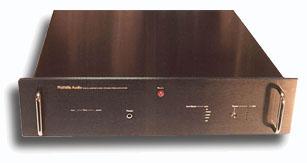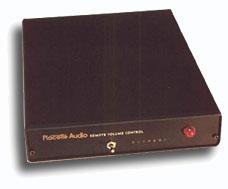![[SoundStage!]](../titles/sslogo3.gif) Home
Audio Home
Audio Equipment Review |
||||||||||||||||
June 1999 Placette Audio Line-Stage Preampand Remote Volume Control by Ken Micallef
Whatever happened to the space age? As a kid growing up in Milford, Michigan, 20 or so miles outside Detroit, I was inundated with visions of the future. From the aerodynamic 1965 Corvette Stingray to chrome toasters that seemed to fly by at 100 mph, ‘60’s society relished the notion of a future where space travel, time travel, even mind-out-of-body travel were a coming staple of daily existence. But with Stanley Kubrick's 2001: A Space Odyssey and then Neil Armstrong's touchdown on the moon, imagining the future was slowly dealt a death blow. Who needs a real moonwalk when you've got Alien, ET, and all those blazing Jedi knights? What does all this have to do with the price of preamps in Idaho? Well, the Placette Audio Line-Stage Preamplifier will make anyone who resides in this modern age, not a nostalgic fuzzy bygone world, a seriously happy humanoid. This is state-of-the-art technology the way God intended. Placette creator and designer Guy Hammel spares no effort or expense in making his line of preamps and one fabulous Remote Volume Control some of the quietest and smoothest-sounding equipment you'll hear. Sold direct with a 30-day no-risk trial period, you won’t find Placette Audio’s products in stores, but you can read about them here. Description The key to this preamplifier is Hammel's ingenious use of Vishay S-102 resistors -- but I am getting ahead of myself (that damn mind-out-of-body thang again). The Placette Preamp is your typical-looking, very deep, matte-black-box-with-brushed-aluminum-faceplate deal. It measures 19"W x 17"D x 5"H and sits on four large spongy Sorbothane feet that resemble big cupcakes. The rear panel of the Preamp features Vampire gold-plated input and output RCA jacks separated to the left and right sides to maintain the dual-mono design, which is claimed to prevent crosstalk while giving the Preamp greater clarity and focus, but more on that later. A "star ground" toggle switch can select "chassis" or "float" positions and thus provide external access to the Preamp’s ultimate ground point -- overkill, but useful with noisy phono hookups. The CD inputs and one pair of outputs are marked with an extra red ring, designating these as OFC (oxygen-free copper) jacks for the most critical components. The front panel also has a headphone jack, LED indicators for tape play and record, and the five input selectors (CD, phono, tuner, tape, video, aux and mute). More inputs are available, as Hammel will customize the Preamp to your preferences. A big red eye, which never actually lights up, is the remote sensor, not the power indicator as I thought (no on/off switch here; this baby should stay powered at all times). A tiny toggle switch controls the volume, or, preferably, you can use the supplied remote, which controls all functions, the most important one being the 126-step volume control (this should not to be confused with the Placette Remote Volume Control, which I’ll discuss later). This is represented on the Preamp by seven LEDs which, when activated by the remote, zoom up and down like George Jetson with a jetpack. "The volume is controlled by a microprocessor unit that selects various configurations of Vishay S-102 resistors," explains the operation guide. The Placette Preamp uses no less than 40 of these resistors. "The remote control will step up or down slowly for a few steps and then speed up. The front-panel control [toggle switch] is much faster in operation and is not intended for precise settings. The full range of the volume control is 126 repeatable steps.... The [red] MSB [‘Most Significant Bit’] indicator on the front panel indicates that the volume control is at least halfway up and is only a warning about possible high outputs. Just go by the highest LED that is lit and ignore the ones below it…." System and sound OK. Heavy duty, high-quality parts and construction befitting its $3000 price, premium Vishay resistors, a remote control that is as smooth and creamy as Mike Myers purring "butter," but how does it sound? I must say, being a certified tube head, and even with Placette's high-quality innards, I didn't relish the idea of solid-state sound. Nonetheless, I did my duty, placing the Placette in my rack with the Cary SLM-100 monoblocks, Theta Data II transport, Genesis Digital Lens, and Muse Model II DAC, alongside Audio Physic Virgos, connected throughout with JPS Labs Superconductor+ cable. Power cords are JPS Labs, Synergistic Research, and Cardas; Townshend Seismic sinks are also used. My preamp for comparison is the Audio Note M2, which is perhaps my favorite piece of gear. The Audio Note (outfitted with NOS Mullard and Tung-Sol tubes! Yes!), in combination with the Carys, offers to me ultimate tube sound. To some, this might mean colored sonics, slow transients, and boomy bass. But in my system, it means incredibly lifelike and natural fidelity, placing everyone from Pat Metheny, Hank Mobley, and Tom Petty, to George Solti and Bartok front and center in my listening room. I've had McCormack, Audiolab, and Melos gear in my system, but I'm sold on the Audio Note/Cary combo. The Placette Preamp just cleared the sides of my Standesign rack, and it was a breeze to connect. Those big Vampire jacks are way easier to grab onto than the Audio Note's rather flimsy and recessed RCAs. I powered up the unit, put in a Frank Zappa CD, and went back to work in the other room of my tiny two-room Manhattan apartment. "Let the solid-state toy burn in a bit," I mused. Wanna give it a fair shot after all. Much to the chagrin of Guy Hammel, I kept the thing warmed up and cooking for around five months as I kept switching back and forth between the two preamps hoping to come to some semblance of a review. The first thing that hit me between the ears was the soundfield. Like light blasting into a dark room, the Placette Preamp imparted new clarity and focus to my rig. You want detail? In spades. Bass to the gut? Abs beware. Especially riveting were the transients. While the Audio Note preamp is no slouch for a tube unit, the Placette simply ushers in a new level of resolution and relief. Everything was faster (but not brighter), from Paul Wertico's ride cymbal on Pat Metheny's Imaginary Day [Warner Bros. 46821], to Tom Petty's grouchy vocals on his latest depressing epic, Echo [Warner Bros. CDW 47294]. The entire soundfield seemed somehow elevated and more transparent, with more of a see-through quality which was evident throughout. The brass sections in Bartok's Concerto for Orchestra, Eric Leinsdorf and Boston Symphony Orchestra [BMG 09026-63309], was particularly bold, bad-assed and beautiful. A good test for depth of soundstage is to play the last note of The Beatles' "A Day In the Life" from Sgt. Pepper’s Lonely Heart's Club Band [EMI CDP 7 46442 2]. You know, after the massive crescendo, the orchestra plays one final note that resounds into infinity. At the very moment of the crescendo note, in a good system, that millisecond of echo after the note will wrap around your ears and nail you to your seat. With the Placette, that effect was honestly a shock, the kind this jaded listener doesn't get very often. The Placette's brilliant ability to resolve inner detail and present music largely uncolored is admirable. But, after much A/B comparison, I also noticed a slight coldness and lack of tubelike dimensionality to the Placette's overall character. Perhaps this is why I prefer tubes to begin with. While the Placette is accurate to a fault and quick-witted as Dennis Miller, I prefer the Audio Note's slightly more good-humored and forgiving outlook. The Placette makes mincemeat out of the Audio Note's subdued and rather polite presentation. It also has the kind of bass slam that you associate with solid-state gear. The Audio Note's bass was actually more potent, yet less well-controlled than the Placette’s. In terms of neutrality, the Placette Preamp wins easily. Still, the Audio Note offers the kind of supple sound and larger-than-life aesthetics that I can't resist. Hammel's unit is a realistic solid-state man in a world of soft-brained tube guys, a unit so clean, it could be used for a mission-control device. And the Preamp’s remote control is an utter joy to use. I may be mistaken, but it is more accurate than any conventional hand-adjusted volume knob I have ever used -- a very sophisticated device indeed. All the more reason I couldn't wait to hook up the Placette Preamp's baby brother, the Remote Volume Control, whose name announces its function, to my Audio Note preamp. Measuring just 7"W x by 9 1/2"L x 1 1/2"H, the Remote Volume Control also features the round red eye like its big brother, with toggle switch and seven LEDs. Its rear panel features two sets of Vampire RCAs, as well as a line for its power wall-wart. Connecting the tiny box between my DAC and preamp, I adjusted the remote (separate from the hand-held remote supplied with the Line-Stage Preamp), again making note of the infinitesimal adjustments in volume one can make with this astounding control device. The remote control performed as effortlessly as the Preamp, with the same degree of elegance and, most importantly, with no hint of added distortion or sonic manipulation. I was again rewarded with that space-age "touch of a dial" ease from my padded cell -- er, listening chair -- and with the sound of my beloved preamp and DAC gloriously intact. If you covet this ideal, Placette’s Remote Volume Control is your ticket. Conclusion The best of both worlds: my Audio Note preamp and the precise Placette Remote Volume Control. I am a happy shiny humanoid. All is right with the audio world. The Placette Audio Line Stage Preamplifier is a subtle-looking box that offers unparalleled functionality, noble transparency, immaculate imaging and smooth-as-silk sound. But it is not a tube preamp. For me, nothing is -- other than a tube preamp, that is. While I see a possible future home for the Remote Volume Control (mine!), I could also envision the Placette Audio Line-Stage Preamplifier as a change-of-pace stand-in should the Audio Note preamp ever need a rest or upgrade. Old technology is funny that way…. ...Ken Micallef
|
||||||||||||||||
|
||||||||||||||||
![[SoundStage!]](../titles/sslogo3.gif) All
Contents All
ContentsCopyright © 1999 SoundStage! All Rights Reserved |
 Line-Stage Preamp
Line-Stage Preamp